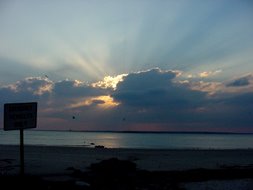Christmas Pomanders - Fragrant and Festive Symbols of Prosperity and Good Luck
Have you ever smelled the spicy fragrance of clove studded oranges? The wonderful fragrance of citrus and cloves filled the air as I worked on this painting of "Spicy Christmas Treats".
 For my painting, I made orange pomanders by piercing fresh oranges with whole cloves. Click here for more about making pomanders.
For my painting, I made orange pomanders by piercing fresh oranges with whole cloves. Click here for more about making pomanders.
Next, I positioned the orange pomanders on a plate so that the pattern of cloves made an intersecting line with a red bow and candy cane. This strengthened the painting's composition by using both line direction and color contrast in the center of interest also called the "focal point".
I used a cool greenish gray background to contrast with the warm red and orange colors of the fruit and candy. In art as in life, contrasting elements add impact and interest. The important thing is to keep it all in balance.
Clove studded fruit has been a favorite holiday tradition since the 15th century. England's Queen Elizabeth I was reported to have always worn a pomander. Read more about the history of pomanders at this link.
In the ancient customs of Europe and China, oranges have been given as New Years gifts to symbolize a wish for prosperity and good fortune.
With this painting of orange pomanders, I too wish you peace, prosperity and good fortune in the New Year.




 brushes. I've found panels are sturdier than paper supports when using these vigorous pastel techniques.
brushes. I've found panels are sturdier than paper supports when using these vigorous pastel techniques.








 I look forward to more painting in the moonlight - It's an exciting challenge to try capture in paint the subtle beauty of the moon!
I look forward to more painting in the moonlight - It's an exciting challenge to try capture in paint the subtle beauty of the moon!
 In this post I'm using birch plywood and fiber board as supports for canvas panels. I prefer 1/4 " or 1/2" birch plywood to fiber board (or white board) because of it's strength and resistance to warping in sizes up to 11" x 14".
In this post I'm using birch plywood and fiber board as supports for canvas panels. I prefer 1/4 " or 1/2" birch plywood to fiber board (or white board) because of it's strength and resistance to warping in sizes up to 11" x 14".


 like books or
like books or  air dried on a flat surface.
air dried on a flat surface. The dried and trimmed canvas panels get another coat of gesso.
The dried and trimmed canvas panels get another coat of gesso. When the gesso has dried, the canvas panels are ready for use.
When the gesso has dried, the canvas panels are ready for use.










 adding more enticement to "do research for my art" by relaxing and absorbing all the sights and sounds of this unseasonable warm afternoon.
adding more enticement to "do research for my art" by relaxing and absorbing all the sights and sounds of this unseasonable warm afternoon.













